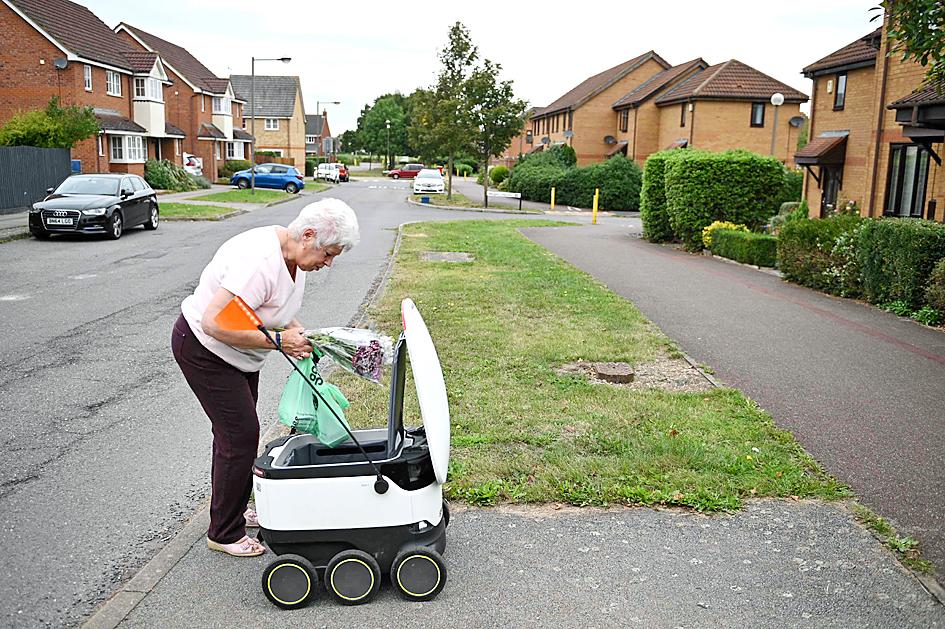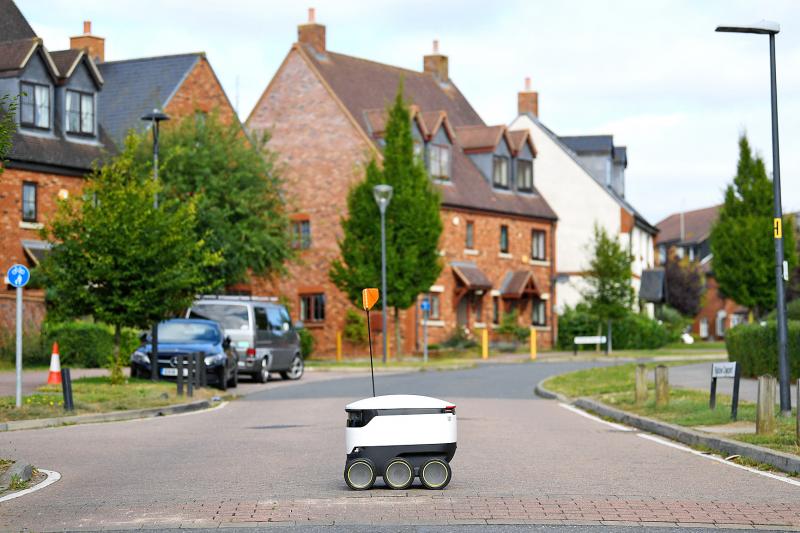It is famous for its roundabouts and statues of concrete cows, but the English town of Milton Keynes now has another claim to fame — a trundling army of shopping delivery robots.
The six-wheeled automated vehicles, launched three years ago, barely get a second glance as they ply the residential streets, about 80km north of London.
The number of robots has grown to 200 in Milton Keynes and nearby Northampton, which introduced the service last year, with plans for as many as 500 to be in action in five more places across the country.

Photo: AFP
According to the robots’ operators, the squat white machines came into their own when the UK locked down last year as COVID-19 hit the country.
“Everyone was so in need of contactless delivery during the pandemic,” Starship Technologies head of UK operations Andrew Curtis said.
The US company, which has quadrupled its deliveries in the UK, now makes 1,000 deliveries a day.

Photo: AFP
“Demand hasn’t dropped off,” Curtis said, adding that as stay-at-home restrictions were lifted, users became more willing to try the technology.
The company has signed a new agreement with longstanding partner the Co-op Group’s chain of supermarkets, to provide 300 new robots by the end of the year and triple deliveries.
In front of one of the retailer’s shops in Milton Keynes, which was the first to use the delivery machines in 2018, a dozen robots are ready and waiting. With their antenna topped with an orange flag to aid visibility, they look almost like a queue of empty bumper cars.
STARSHIP TROOPERS
An employee emerges from the shop and places the newest order inside one of the robots — a small bag containing raspberries, yoghurt and a bouquet of flowers.
With its lid locked, the droid immediately dashes out onto the pavement. It turns and moves forward to cross the road before stopping, reversing suddenly to let a car pass.
Fitted with cameras, sensors and a loud alarm if needed, the robots — first created in 2014 by the two founders of Skype — are 99 percent autonomous, but if they become stuck, an operator can take control.
Once launched, the robot navigates the maze of footpaths that wind between Milton Keynes’ red brick houses.
When the way is clear, it can reach speeds of up to 6kph — a little more than a reasonable walking pace. Deliveries reach customers in less than an hour.
The Co-op said the use of the robots is environmentally friendly, as well as convenient, with 70 percent of Starship’s customers not taking a trip in a vehicle to a store or receiving a delivery from a fuel-powered vehicle.
Under the delivery system, the robots remain the property of Starship and orders are placed via an application they developed.
The company manages 1,000 robots, mainly in the UK and the US, but also in Estonia, Germany and Denmark.
The tech firm is not alone in the delivery robot race. For example, in the US where it operates mainly on university campuses, it is jockeying for position with start-ups and logistics giants such as Amazon.com Inc and FedEx Corp.
A ‘GODSEND’
As their numbers grow, the wheeled delivery drones have drawn criticism from unions, who fear they could take jobs from people. The debate has made its way into US town halls, which are tasked with deciding limits on delivery journeys and rules around sharing the pavement.
“Fortunately, we’ve not had any accidents so far,” Curtis said, adding that Starship has obtained permission from local authorities in the UK for each of its operating locations.
The robot carrying raspberries, yoghurt and flowers continues its journey, hesitating as it encounters a gaping hole, the result of ongoing road maintenance. Roadworkers look non-plussed as they put down planks to bridge the gap.
When the delivery robot finally reaches its destination, Sheila Rose, 71, walks out of her house and unlocks it with her smartphone, to retrieve her groceries and blooms.
“If I can use it, anyone can,” she said, leaning on a walking stick.
“Because of my ill health, I have problems getting out to the shops,” she said, calling the robots a “godsend.”
The delivery drones have become so essential to the septuagenarian that some weeks she uses them every day.
“I’ve got great-grandchildren, and they love it,” she added.

SEEKING CLARITY: Washington should not adopt measures that create uncertainties for ‘existing semiconductor investments,’ TSMC said referring to its US$165 billion in the US Taiwan Semiconductor Manufacturing Co (TSMC, 台積電) told the US that any future tariffs on Taiwanese semiconductors could reduce demand for chips and derail its pledge to increase its investment in Arizona. “New import restrictions could jeopardize current US leadership in the competitive technology industry and create uncertainties for many committed semiconductor capital projects in the US, including TSMC Arizona’s significant investment plan in Phoenix,” the chipmaker wrote in a letter to the US Department of Commerce. TSMC issued the warning in response to a solicitation for comments by the department on a possible tariff on semiconductor imports by US President Donald Trump’s

The government has launched a three-pronged strategy to attract local and international talent, aiming to position Taiwan as a new global hub following Nvidia Corp’s announcement that it has chosen Taipei as the site of its Taiwan headquarters. Nvidia cofounder and CEO Jensen Huang (黃仁勳) on Monday last week announced during his keynote speech at the Computex trade show in Taipei that the Nvidia Constellation, the company’s planned Taiwan headquarters, would be located in the Beitou-Shilin Technology Park (北投士林科技園區) in Taipei. Huang’s decision to establish a base in Taiwan is “primarily due to Taiwan’s talent pool and its strength in the semiconductor

An earnings report from semiconductor giant and artificial intelligence (AI) bellwether Nvidia Corp takes center stage for Wall Street this week, as stocks hit a speed bump of worries over US federal deficits driving up Treasury yields. US equities pulled back last week after a torrid rally, as investors turned their attention to tax and spending legislation poised to swell the US government’s US$36 trillion in debt. Long-dated US Treasury yields rose amid the fiscal worries, with the 30-year yield topping 5 percent and hitting its highest level since late 2023. Stocks were dealt another blow on Friday when US President Donald

UNCERTAINTY: Investors remain worried that trade negotiations with Washington could go poorly, given Trump’s inconsistency on tariffs in his second term, experts said The consumer confidence index this month fell for a ninth consecutive month to its lowest level in 13 months, as global trade uncertainties and tariff risks cloud Taiwan’s economic outlook, a survey released yesterday by National Central University found. The biggest decline came from the timing for stock investments, which plunged 11.82 points to 26.82, underscoring bleak investor confidence, it said. “Although the TAIEX reclaimed the 21,000-point mark after the US and China agreed to bury the hatchet for 90 days, investors remain worried that the situation would turn sour later,” said Dachrahn Wu (吳大任), director of the university’s Research Center for